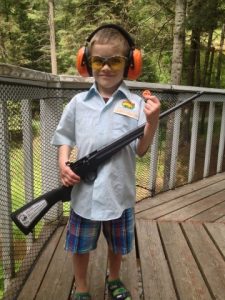 I was helping out with a dads and sons shooting event from our church awhile back and it highlighted a very important lesson in firearms training…which comes first, precision or accuracy?
I was helping out with a dads and sons shooting event from our church awhile back and it highlighted a very important lesson in firearms training…which comes first, precision or accuracy?
If you’re fuzzy on the difference, a precise 5 shot group would all go through the same hole, regardless of where that hole is on the paper.
An accurate 5 shot group would have an average center point right on the bullseye, but the shots might be spread out 6-8” away from each other.
An accurate AND precise group would drill shot after shot on top of one another in the center of the bullseye.
One of the things that happened with the boys was that they were competing with each other from the start…even when we were trying to discourage it.
Some of the guns had traditional notch and post or peep sights. Some were sighted in and others weren’t.
Still one other rifle was an AR style .22 with a raised red dot sight that was 2″ above the boreline of the rifle.
We made a point at the before they started shooting to tell them to focus on aiming for the center of the bullseye with every shot, regardless of where their previous shots had hit.
Why?
For the most part, if you always aim at the same spot, a tight group means you’ve got your fundamentals dialed in and a loose group means that you don’t.
It’s way easier to make correct adjustments to the sights when you’re adjusting based on multiple shots in a tight group.
If you shoot a tight group that’s not on the bullseye, it’s usually safe to adjust the sights to move the group to the bullseye.
But if you’re continually chasing your shots, trying to adjust based on where your last shot hit, you never know whether your misses are due to an issue with shooting fundamentals or misaligned sights.
In the case of the outing with the boys, it was interesting to see their competitive nature kick in.
On the first round, some were fine having 6” groups at 10 feet as long as they got 1 shot in the “x”. Others were fine having a 1” group that was 2” low (because of the mechanical sight offset on the AR). The first group thought they were performing better because they hit the “x”.
But when it was time for the 2nd round, the first group still had wide groups and the second group aimed 2” high and got all of their hits in the bullseye.
I see this with adults shooting rifles and pistols as well. They’ll chase their holes all around the paper, blaming loose groups on the gun and the sights without taking the time to shoot a precise group.
When they calm down, trust the sights, and keep aiming at the same spot, they usually find out that the gun and sights are fine and putting rounds right where they are supposed to be going.
One of the big lessons here is the importance of trust, confidence, and emotion in shooting performance. If you trust your weapon, have confidence in your ability, and deaden your emotions as much as possible while shooting, it becomes a mechanical, predictable process. Flinch goes away, mashing the trigger goes away, and, amazingly enough…shots start going where they’re supposed to. And THAT’s something you can get emotional about.
This is a lot easier to do if you’re intimately familiar with your firearm and with handling your firearm.
The more automatic your gun handling skills, the easier it is to perform at a high level under stress.
If your gun handling skills are automatic, it leaves bandwidth in your brain to take care of things like not getting dead, positive threat identification, moving without falling, and more.
If you own a firearm for self-defense, that’s what you need…automatic skills…because nothing else will get the job done when lives are on the line.
And, if you want to get them as fast and affordably as possible, you need to check out >THIS TRAINING< today.

1 Comment
Wes Boozer
June 19, 2019Well stated and easily explained. A great teaching example and tool. Another home run!
Leave A Response